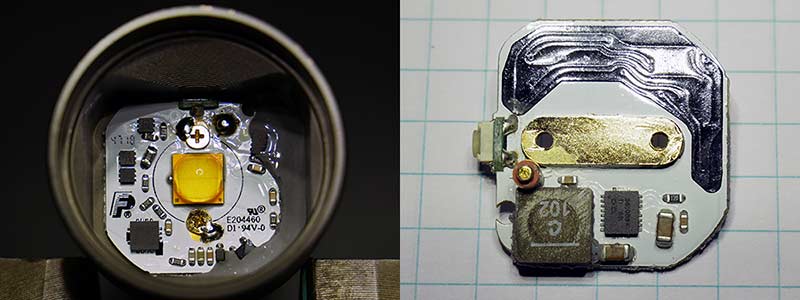The front bezel is a typical interference fit - very compact and well machined. I tried one quick attempt to pry it with a small pry tool, but the fit was too tight - didn't want to damage the ring or the flashlight... it is a $120 flashlight after all!
So, I heated up the outer shell with hot air and cooled the ring with an aerosol freeze spray. Then immediately, one sharp blow to the ring with a small hammer and I got the ring out. The glass didn't break but perhaps I was lucky. I have a fair bit of experience taking apart consumer electronics so this is probably the most tricky to do, but not too difficult with some experience I think.
The reflector looks custom and is very well machined - fits perfectly in the body, and the hole at the bottom is surprisingly big. There is one big O ring around the lip that creates the waterproofing seal and it's compressed in very well. However, you can't just press the glass down to move the O ring because the O ring looks like it's being compressed radially instead of axially, so there is basically no play in the bezel ring fit in the z-direction. The tight tolerances of the ZL machining help make this work. I was hoping to replace the reflector with a TIR optic to fix the tint shifting, but none I could find fit without modification and maintaining a good deal, so I decided to just leave it be just to keep this one as original as possible. I figured that the ZL SC700d makes for a great 'benchmark' light.
Removal of the board is more tricky because it's potted in, and one of the main connections is soldered down to the spring PCB with a solid metal post instead of a wire. The spring PCB is glued down and impossible to reach with a soldering iron, but I managed to desolder the joint. I used a very high power Metcal iron and I'm not sure if a typical soldering iron would do the job without risk of damaging the joint on the other PCB or damaging the plated TH pads.
Potting was the easiest to remove. I flooded the bay with isopropyl alcohol and used needle tweezers, and it came out safely.
The only thing I think can be done to mod this flashlight is to either replace the LED with another XHP70 (it's in 6V configuration), but I suspect most people will have trouble replacing it because it's bonded in two parts (half to the PCB and half to the gold-plated copper block, so reflow is going to be tricky if you don't have the right tools), or an easier mod would be to de-dome the LED to reduce the tint-shifting (likely you get 1 good attempt at it!), or to add some sort of filter film to the glass.
Fitting it back requires care as well. I cleaned up the internals, re-tinned and refluxed, and resoldered on the main connection to the spring PCB. I also cleaned up the silicone potting to make sure there wasn't any contaminants or loose pieces of potting, and reassembled it back, taking care to reprep the surfaces with thermal paste (I used arctic silver). The two screws serve both to clamp the LED onto the body, as well as a high current path for the negative terminal, so the screw are in fact soldered on. Those were easy to desolder, though. I resoldered them back during reassembly.
Finally, I relubricated the seals and pressed the ring back in with an arbor press, but I did file a very tiny notch in the bottom of the bezel ring with a micro file just enough for a pry tool, in case I wanted to reopen it again more easily.
I've been using the ZL for a short while and I'm starting to like the UI more. It's not as fun as Anduril for sure, but it definitely is very practical and works really well 'in the field' as a utility tool.
For a moment I thought about building a driver to replace the ZL driver with the Lume X1 design with Anduril, but it's challenging enough for most folks without the right tools to mod that I'm not sure if it would be practical. A ZL with Anduril though, that would be fun!..



